The Positions of the Planets
by Dr Jamie Love © 1997 - 2011
© 1997 - 2011
 © 1997 - 2011
© 1997 - 2011
You will have noticed from your evening observations that the
stars are all slowly "moving" westward. The Earth's
rotation is responsible for the nightly movement of stars but
it is the Earth's motion around the Sun that is responsible
for this seasonal, or monthly (or weekly), movement of the stars.
Indeed, it is this long term motion that dictates our evening
observations and the course that I am teaching here.
Stars don't change their orientation with respect to
each other so constellations don't change. [In point of fact,
there is some motion among the stars but it isn't noticeable because
the stars are so far away. We'll return to this topic near the end of the course.]
The planets are different. Planets appear to wander through the starfield. Indeed, the word "planet" means "wanderer". Planets seem to wander because they are much closer to us and all of us (the Earth and the other planets) orbit the Sun. This complicates our observations of the planets. We have to keep track of them. Mars may appear to be next to a particular star tonight but it won't be there tomorrow. That's because in 24 hours Mars will have moved over 2 million kilometers in its orbit around the Sun and the Earth will have moved almost 2.5 million kilometers in its orbit too! Plotting those two motions against the fixed starfield, while taking into account the geometry of the problem, leads you to a prediction of how the position of Mars will change with respect to the stars and Earth.
Fortunately the apparent positions of planets follow well-understood equations and are easy to predict with a little effort or a computer program. I won't be teaching you those equations. (Phew!) Professional astronomers learn them - and then often forget them as they come to rely upon their computers to do the hard work. Most amateur astronomers check monthly published predictions like the Night Sky this Month. However, every astronomer, amateur or otherwise, should understand the fundamentals of planetary motion because they affect our observations and the way we describe the planets' positions as seen from Earth.
The first thing to learn is the arrangement of the planets around
the Sun and it is especially important to know where the
Earth's orbit fits into the Solar System.
From closest to the Sun outwards we have the orbits of
....
Mercury
Venus
Earth ("Been there. Done that. Got the T-shirt.")
Mars ("Dying to get the T-shirt!") 
Jupiter
Saturn
Uranus
Neptune
Hey, you forgot Pluto!
Gee, I'd love to forget Pluto because it is such a complication!
Pluto is our most distant known "planet". It's smaller than the Moon, has a very
"skewed" orbit and does not fit the trends in our Solar System. Pluto is very likely an object released from the Kuiper belt (which you will learn about in August).
Recently the International Astronomical Union discussed giving Pluto "dual citizenship"
as both a planet and a minor planet. If Pluto was "demoted" to a mere minor planet the textbooks would have to be rewritten, my favorite website (The Nine Planets) would have to be renamed,
and all astronomy degrees would be called back to the factory
for retooling! 
But seriously, it wouldn't change anything except our perception of Pluto and that would be a good thing. For example, folks at NASA are promoting a mission to Pluto because it is the only "planet" in our Solar System that has yet to be visited (by Earthling machines). This appeals to the public's instincts but has as much scientific merit as completing a collection of baseball cards. On the other hand, a visit to a "Kupier object" could tell us a great deal about the formation of the Solar System and help us to understand how Pluto came to be as it is. But it lacks "collector's appeal".
Gee, I'm sorry I mentioned it. Can we get back on track here?
Opps. Sorry. (You struck a nerve.  )
)
At any time any planet is in a particular position with respect to the Sun and the Earth and that affects our view of it. Astronomers use names for those relative positions that are particularly important or extreme because of the way they affect our observations.
When a planet appears close to any planet or star the planet
is said to be in conjunction. This line-of-sight effect
happens all the time in astronomy. When the planet approaches
the Sun it is in solar conjunction but most folks
just say it is in conjunction and assume you know they are talking
about the planet being in conjunction with the Sun.
By definition a planet at solar conjunction has the same right ascension as the Sun. [You'll recall the definition of right ascension from your first lesson.]
So, at (solar) conjunction the Sun and the planet share the same "sky longitude". They might also have the same declination, but
that isn't relevant here.
|
Obviously solar conjunction is a bad time to look for the planet!
If you were to view our Solar System from far above you would see that when a planet is in (solar) conjunction it is along an imaginary line that extends through the Earth and Sun.
Another term commonly used in observational astronomy is elongation.
Elongation is the angular separation between a satellite
and its primary body. Solar elongation is the angular distance
between the planet and the Sun but most folks just refer
to it as elongation. Do you see a trend here?
When a planet has a (solar) elongation of zero it is in conjunction and that is the worse time to look for the planet.
| 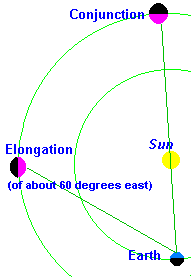 |
OK, when is a planet at its greatest elongation? Midnight? Dawn? When?
That depends on the planet because it depends upon the planet's
orbit with respect to the Earth's orbit.
For observational purposes astronomers divide the planets into
two types, based upon their orbits.
Those with orbits within the orbit of Earth's are called
inferior planets. So Mercury and Venus are inferior (to
the Earth).
Planets with orbits beyond the Earth's are called
superior planets so the superior planets are Mars, Jupiter,
Saturn, Uranus and Neptune.
And Pluto.
I'll pretend I didn't hear that. (But you're right.  )
)
The greatest elongation for the two inferior planets, Mercury and Venus, occurs when the line from the Earth to the inferior planet is at a tangent to the Sun. That's when the Sun-Earth-(inferior)planet angle is greatest. In my drawing here, I show the inner planet close to, but NOT at, greatest elongation - because my drawing program has trouble lining up the tangent. (Sorry.  ) Students who do not understand what I mean by a tangent should not worry about it because that detail is not important. Students who understand that detail, please forgive my inaccurate drawing. Regardless, the greatest elongation occurs pretty close to the way I have drawn it (but you wouldn't want to pilot a spaceship based upon my maps), so you can imagine how it looks. ) Students who do not understand what I mean by a tangent should not worry about it because that detail is not important. Students who understand that detail, please forgive my inaccurate drawing. Regardless, the greatest elongation occurs pretty close to the way I have drawn it (but you wouldn't want to pilot a spaceship based upon my maps), so you can imagine how it looks.
An inferior planet at eastern elongation is seen just after sunset, following the Sun. An inferior planet at western elongation is seen just before sunrise, leading the Sun I hope this diagram helps you understand why. Have a good look at it and remember that the Earth, the blue planet, rotates counter(anti)clockwise. | 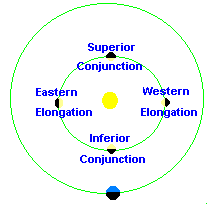 |
I've also labeled two other significant points in the orbit of an inferior planet. When the planet is at conjunction on the far side of the Sun it is at superior conjunction. When the planet is at conjunction on our side of the Sun it is at inferior conjunction. Only inferior planets can experience inferior conjunctions (and we will come back to that point shortly).
The superior planets are best seen at opposition.
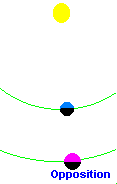 |
Opposition occurs when a planet is opposite the Sun in the Earth's
sky, or to put it another way, opposition occurs when the Earth
is positioned between the planet and the Sun.
Opposition is the opposite of (solar) conjunction. Indeed, a planet at opposition has a (solar) elongation of 180o and it's, therefore, at its maximum elongation. Also, a planet at opposition has an RA exactly 12hr different from the Sun's. At opposition a planet is at its closest approach to the Earth and it will be visible throughout the night. It will rise in the east as the Sun sets in the west and it will set as the Sun rises. That's because, at opposition, the planet and the Sun are 12 hours apart. At local midnight a planet in opposition will be close to, or even on, your meridian. (You'll recall the definition of meridian from an earlier lesson.) |
Let's review what you've learned and highlight some important points.
|
No planet can be seen when it's in conjunction because it is
either behind the Sun (at superior conjunction) or lost
in the Sun's brightness as it passes in front of the Sun
(at inferior conjunction).
A planet is seen best at its greatest elongation. The orbits of the inferior planets restrict their greatest elongations. They are always seen as morning objects (at western elongation) or evening objects (at eastern elongation) but never seen as a midnight object. We often think of the inferior planets as tagging along with the Sun. Notice that it is impossible for an inferior planet to ever be in opposition. A superior planet is best seen at opposition because that is when it is at its greatest elongation and also it is at its closest approach to Earth. Superior planets can be in any RA (or elongation with respect to the Sun) so they are can appear in our night sky at anytime including midnight. Notice that it is impossible for a superior planet to ever be at inferior conjunction although it can be at superior conjunction. | 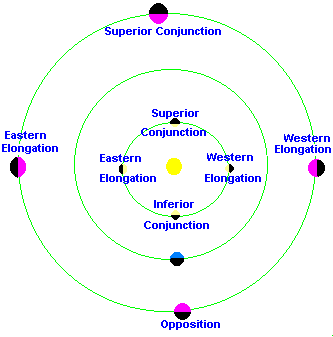 |
Have a good look at this diagram and convince yourself that inferior planets cannot be in opposition and superior planets cannot be in an inferior conjunction. [As a matter of fact, this is a very good diagram to include in your notebook. You should draw this diagram and label its parts. That's a great way to learn it.]
Seems like a lot of terms to learn.
Yes, but they are very good terms to understand because astronomers use them all the time to explain observational events among the planets. If you study these images and learn these terms you will be well on your way to understanding planetary observations and how to communicate your ideas about planetary astronomy.
|
Oh, one other term!
When a superior planet is at a right angle with respect to the Sun as seen from the Earth, that planet is in quadrature.
Superior planets are at quadrature twice in their orbits.
When a superior planet is at quadrature its elongation is 90o.
That is, a line drawn from the planet to the Earth and then to
the Sun will make an angle of 90o. Another way of looking
at it is that a planet at quadrature is exactly 90o from the
Sun as viewed from Earth (so it has an elongation of 90o).
| 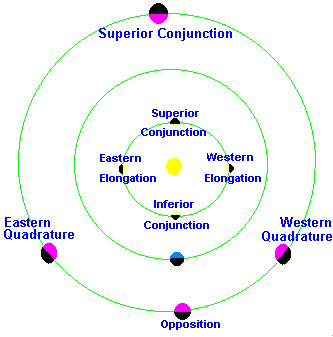 |
|
How about the Moon? Oh, good question! The Moon can also be in quadrature when it forms a right angle with respect to the Sun as seen from Earth. When the Moon is in quadrature its Earthside is half lit so it is either a First Quarter or Last Quarter Moon. | 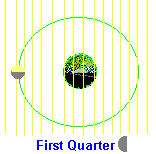 |
As I've said before, these definitions are important because they allow us to easily explain planetary observations. (OK, "easily" once you get the hang of it.)
|
Look at the diagrams as you follow
these explanations.
(The direction of the Earth's rotation is counterclockwise so, in our diagrams, sunrise occurs on the right side of Earth and sunset occurs on the left side of Earth.) At sunset a planet at eastern quadrature will appear near your meridian. It might be best to say that the planet at quadrature will be equal distance between the east and west horizons at sunset. (Roughly.) The Sun will be 90o ahead of it (because a planet at quadrature has an elongation of 90o) so the planet will set 6 hours after the Sun. If the Sun had a right ascension of 10h the planet at eastern quadrature would have a right ascension of 16h. A planet at western quadrature will be near your meridian at sunrise. If the Sun had a right ascension of 10h the planet at western quadrature would have a right ascension of 4hr. |  |
This is difficult stuff!
Yes, it is. Those statements of fact can be derived from the definitions and it is important that you understand what they mean. Don't read them as simple facts to memorise. Read them as exercises for your learning experience. Work through them so you understand why I can make those statements with such certainty.
Here are some more planetary facts on which you can sharpen your planetary skills.
|
Mercury's greatest elongation is 28o so it can never be any further
away from the Sun than 28o. That means the Sun will
always be within 2hr right ascension of Mercury.
[Note that 1hr of right ascension equals 15o. I got that by dividing a 360o circle into 24hrs to give me 15o per hr. That means 2hrs of right ascension equals 30o and Mercury is at 28o greatest elongation so it will always be less than 2hr right ascension from the Sun.] When Mercury is at its greatest eastern ascension it will set in less than two hours after sunset. When Mercury is at its greatest western ascension it will rise less than two hours before sunrise. |  |
I worked right ascension into this lesson and you may have found
it difficult without a map.
I was not being cruel, (Yes you were!  ) I just wanted you to try to imagine the RA changes in your mind's eye.
) I just wanted you to try to imagine the RA changes in your mind's eye.
In the next diagram I'll include a
"backdrop" of RA points to help you work through this
next example with Venus.
|
Note that the RAs could be anything because
the Sun has a different RA every day due to the Earth's
orbital motion. Concentrate on the differences not the
values. Also notice that the RAs increase counterclockwise,
just like in our sky.
(And you now know that one RA is 15o.) Venus has a maximum elongation of 47o, so at its greatest eastern elongation Venus will set about three hours after sunset. If the Sun has a right ascension of 10hr while Venus is at its greatest eastern elongation then Venus will have a right ascension of about 13hr. When Venus is at its greatest western elongation it will rise about three hours ahead of the Sun. If the Sun has a right ascension of 10hr while Venus is at its greatest western elongation then Venus will have a right ascension of about 7hr. | 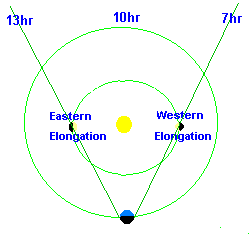 |
The above "exercises" are particularly important in observations because they prove how much easier it is to see Venus than to see Mercury. You can imagine Mercury's orbit within that of Venus and even estimate the RAs to imagine the effect of Mercury's tighter orbit. Mercury is usually lost in the Sun's glare and even at its best times, at its greatest elongation, Mercury is still pretty close to the Sun. I find it impossible to see anything within 1 right ascension of the Sun and even 2 RAs is barely enough for a dim planet like Mercury.
Now that you have an RA direction to guide you, go back (up) a few screens and see if the stuff about RAs made sense. Then, if you like, you can move on to our last lesson for this month where you will learn how the motion of the planets causes important events.








